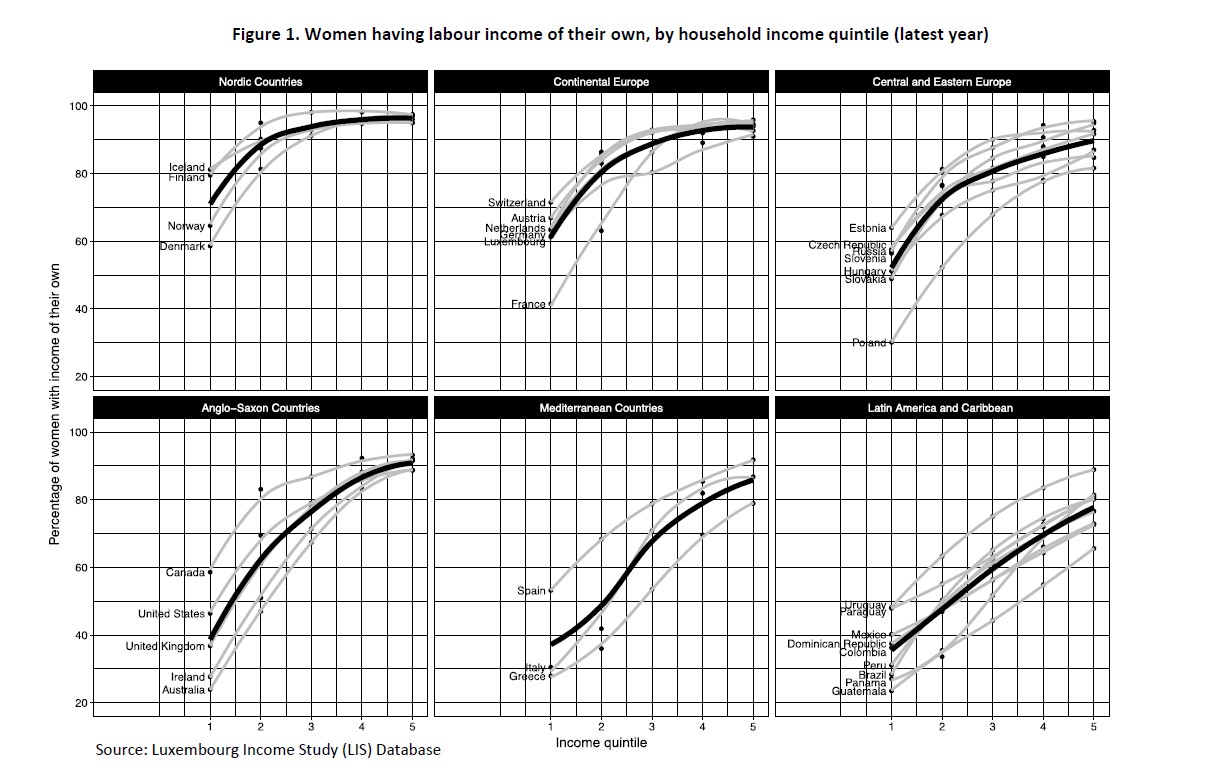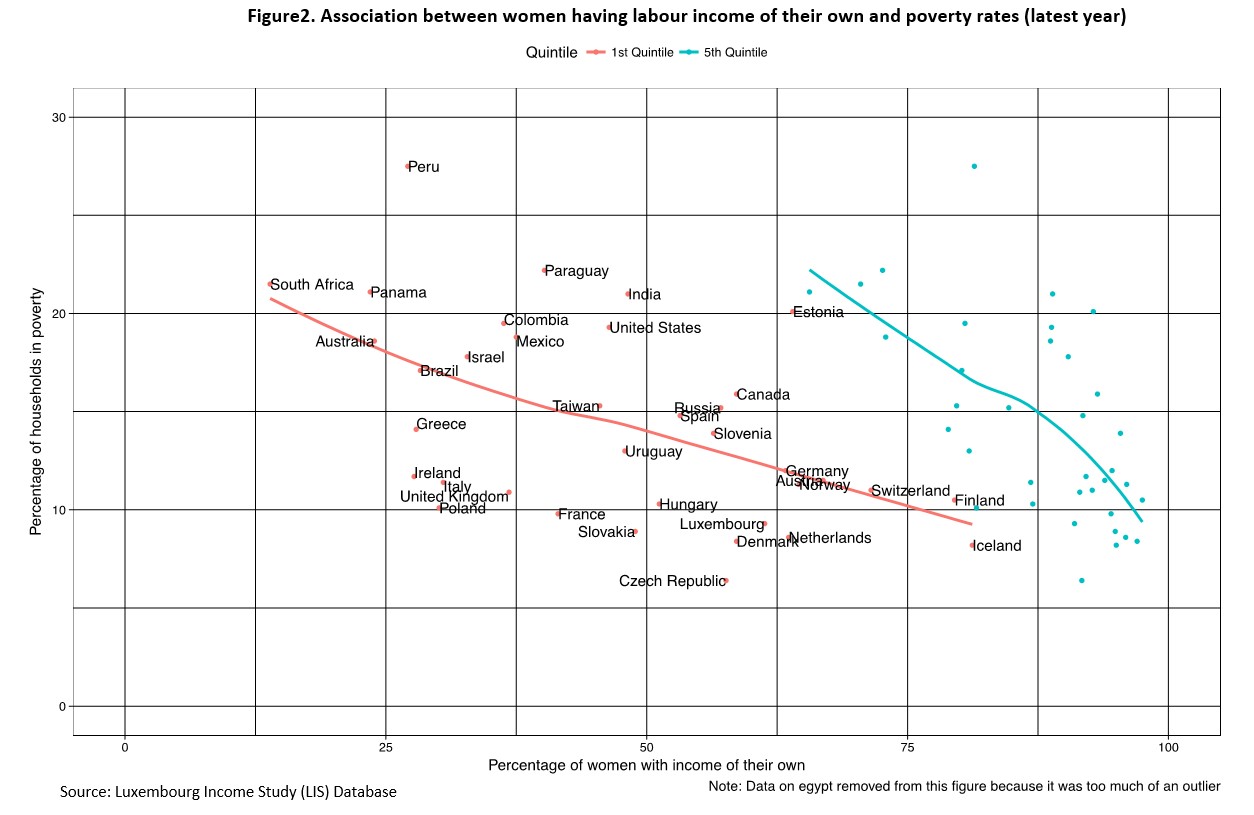Issue, No.4 (December 2017)
Gender equality and poverty are intrinsically linked1
Prominent analyses of economic inequality often fail to incorporate gender equality, or address it as a rather isolated subject (Piketty, 2014; Atkinson, 2015; Milanovic, 2016), of course with notable exceptions (Gornick & Jäntti, 2014; Boushey, DeLong, & Steinbaum, 2017). Yet, in addition to reasons of social justice, understanding economic inequality from a gender perspective, with attention to economic inequality within households and women’s economic independence, is crucial for a multitude of reasons. First, women without labor income of their own typically will not qualify for “first class” social insurance but will have to rely on less generous, “second class”, social assistance. Secondly, in times of increasing family diversity, including relationship dissolution and single parenthood, having to rely on a single income puts greater demands on economic independence, and having been economically independent prior to separation is a great resource in that respect (Nieuwenhuis & Maldonado, 2018). Thirdly, access to and control over household income are not necessarily shared equally among (adult) household members (Bennett, 2013). Finally, gender equality contributes to other goals, that include reducing income inequality among coupled households (Nieuwenhuis, Van der Kolk, & Need, 2017), and protecting households against poverty (Nieuwenhuis, Van Lancker, Collado, & Cantillon, 2016).
Using data from the Luxembourg Income Study (LIS) Database, (technical details available upon request), this brief report suggests that there is an association between (working age) women having a labor income of their own and poverty rates across high- and middle-income countries. It is beyond the scope of this brief report to detail the explanations for trends in women’s employment and economic independence. Yet, it is important to briefly note that the gender revolution has been described as “uneven and stalled” (England, 2010, p. 149), and that there is considerable consensus on how working women can be supported (Gornick & Meyers, 2003), including (but not limited to) paid parental leave and affordable and available public childcare services of high quality (Olivetti, & Petrongolo, 2017). In the absence of such institutional conditions, particularly lower educated women are outside of the labor market (Korpi, Ferrarini & Englund, 2013).
Results

In Figure 1 we visualize the degree to which women (aged 25-54) have labor income of their own, across countries and by household income quintile. This labor income includes wages as well as short-term wage replacements, such as maternity/parental pay, sickness and work injury pay, and unemployment benefits. The grey lines represent individual countries, and the thicker black lines an average by region (using a LOESS curve). Compared to the Nordic countries, Anglo-Saxon countries, typically with market-driven solutions to work-family reconciliation policies, and Central and Eastern-European countries, show slightly lower percentages of women with independent labor income. Markedly fewer women have their own income (through labor) in the Mediterranean countries, and Latin America and the Caribbean. The black lines are steeper in countries that typically have weaker institutional support for working women, indicating that their likelihood of having an own income is lower particularly among low-income households and in some countries also in middle-income households. In the Nordic countries, and to a lesser extent in Continental Europe, the line is much more level for the middle- and higher income quintiles. This observation allows for two interpretations, that need not be mutually exclusive. The first is that in many countries dual-income households are a near-prerequisite to earn a top-quintile income. The second is that women’s employment is socially stratified, with those women with more limited earnings potential not having their own income particularly in those countries with limited institutional support for women’s employment (Korpi, Ferrarini, & Englund, 2013).

In Figure 2, we associate relative poverty risks1 (among all families) with the percentages of women having an income of their own, for women in households in the first and fifth income quintile. The results are clear: poverty rates are lower in countries where a larger share of women have an income of their own. Particularly women not having labor income of their own in low-income households seems to be important in relation to countries’ poverty rates. Although this association is not intended to convey a causal effect, this evidence clearly suggests that gender equality and economic inequality are closely linked. Countries differ particularly in the degree to which women in low-income households have an income of their own, which not only is an indicator of gender inequality but also associated with these countries’ poverty rates.
Conclusion
Women having income from labor (or short-term wage replacement) of their own is not only an important indicator of gender equality, but it is also linked to economic inequality in the form of poverty. An important pattern was observed that in countries where many women have an income of their own, poverty rates were lower. This suggests that gender inequality and economic inequality (in the form of poverty) are best understood in conjunction with each other, rather than as isolated issues.
It should, of course, be made clear that the mere existence of the association between women’s economic independence and poverty rates in a country does not imply causality. For that, more detailed research is required. The current associations, for instance, do not make clear whether women having labor income of their own are indeed less likely to be poor. With the rise of in-work poverty, this needs not be the case (Lohmann & Marx, 2018). The results also do not show whether women’s economic independence is associated with reductions in poverty among single women (including single parents) or among women in couples. Nevertheless, the introduction listed four reasons why integrating gender into discussions on economic inequality is important. With the relevant caveats in place, the results presented here indeed suggest that promoting gender equality has the, often underexplored, potential of reducing inequality and in particular poverty. As mentioned above, this brief report is based on (and contains parts of) a background paper that was commissioned by UN Women’s Research & Data Section as a background paper to feed into Progress of the World’s Women Report 2018, and Gender Equality in the 2030 Agenda for Sustainable Development 2018. With respect to the United Nations’ Sustainable Development Goals, progress has been made with regards to sustainable development goal #5 to achieve gender equality and empower all women and girls. Although often ignored in major analyses of economic inequality, efforts towards greater gender equality also pay off in terms of achieving other sustainable development goals such as #1 to end poverty (understood as relative poverty here) in all its forms everywhere and #10 reduce inequality within and between countries. More generally, in times of high and rising inequality and poverty, Atkinson (2015) warned that the limits of redistribution were in sight, and that inequality before redistribution should be addressed. Promoting gender equality in the labor market is one way of doing so.
1 This brief report is based on joint work with Teresa Munzi, Jörg Neugschwender, Heba Omar, and Flaviana Palmisano, based on pre-defined tables. The work was commissioned by UN Women’s Research & Data Section as a background paper to feed into Progress of the World’s Women Report 2018, and Gender Equality in the 2030 Agenda for Sustainable Development 2018. The current brief report highlights selected findings. The full background paper, including more technical details, is available upon request.
2 At Risk of Poverty Rates (AROP, 50% of median equivalized disposable household income)
References
| Atkinson, A. B. (2015). Inequality: What can be done? Cambridge, Massachusetts: Harvard University Press. |
| Bennett, F. (2013). Researching Within-Household Distribution: Overview, Developments, Debates, and Methodological Challenges. Journal of Marriage and Family, 75(3), 582–597. |
| Boushey, H., DeLong, J. B., & Steinbaum, M. (Eds.). (2017). After Piketty: The Agenda for Economics and Inequality. Cambridge: Harvard University Press. |
| England, P. (2010). The Gender Revolution: Uneven and Stalled. Gender & Society, 24(2), 149–166. |
| Gornick, J. C., & Jäntti, M. (Eds.). (2014). Income inequality: Economic disparities and the middle class in affluent countries. Stanford, California: Stanford University Press. |
| Gornick, J. C., & Meyers, M. K. (2003). Families that work: Policies for reconciling parenthood and employment. Russell Sage Foundation. |
| Korpi, W., Ferrarini, T., & Englund, S. (2013). Women’s Opportunities under Different Family Policy Constellations: Gender, Class, and Inequality Tradeoffs in Western Countries Re-examined. Social Politics: International Studies in Gender, State & Society, 20(1), 1–40. |
| Lohmann, H., & Marx, I. (2018). Handbook on In-Work Poverty. Edward Elgar. |
| Milanovic, B. (2016). Global Inequality: A New Approach for the Age of Globalization. Cambridge: Harvard University Press. |
| Nieuwenhuis, R., & Maldonado, L. C. (Eds.). (2018). The Triple Bind of Single-Parent Families: resources, employment and policies to improve well-being. Bristol: Policy Press. |
| Nieuwenhuis, R., Van der Kolk, H., & Need, A. (2017). Women’s earnings and household inequality in OECD countries, 1973–2013. Acta Sociologica, 60(1), 3–20. http://doi.org/10.1177/0001699316654528 |
| Nieuwenhuis, R., Van Lancker, W., Collado, D., & Cantillon, B. (2016). Has the potential for compensating poverty by women’s employment growth been depleted? LIS Working Paper Series, (664). |
| Olivetti, C., & Petrongolo, B. (2017). The Economic Consequences of Family Policies: Lessons from a Century of Legislation in High-Income Countries. Journal of Economic Perspectives, 31(1), 205–230. http://doi.org/10.1257/jep.31.1.205 |
| Piketty, T. (2014). Capital in the twenty-first century. Cambridge: The Belknap Press. |
